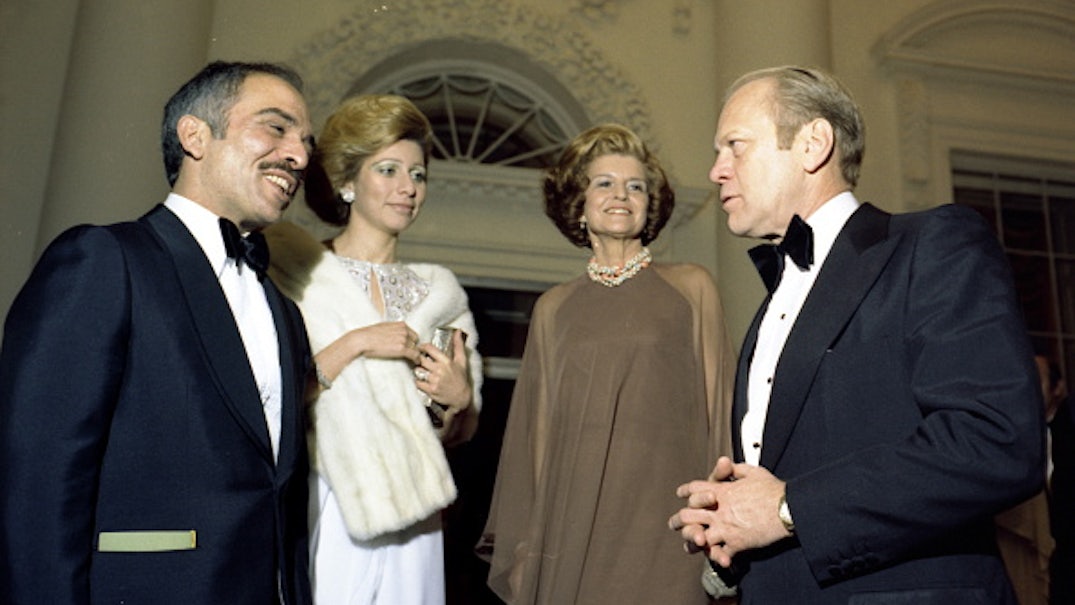From left, King Hussein of Jordan, his wife Queen Alia-al-Hussein, First Lady Betty Ford, and President Gerald Ford during one of Hussein’s many visits to the White House, March 30, 1976. Photo Credit: Universal History Archive/Getty Images
By David Kurlander
King Hussein’s political destiny took a number of sharp turns in the early 1970s. After fighting against Israel in the 1967 Six Day War, Hussein became increasingly uncomfortable with the radicalism of the Palestinian Liberation Organization, whose guerilla groups were trying to wrest control from Jordan of the contested West Bank. The tensions burst open in September 1970, when PLO militants hijacked three airplanes, landed them in Amman, and—after evacuating them—blew them up on the tarmac in a show of force against Hussein’s monarchy. The King responded by decimating PLO forces, reinforcing his reputation in the Arab world as a Western-friendly playboy without ideological scruples. Matters deteriorated further when Jordan sat out the 1973 Yom Kippur War against Israel, leading to a seismic proclamation by the Arab League that the PLO was indeed the West Bank’s only legitimate government.
Around February 1974, Hussein started asking Secretary of State Henry Kissinger for surface-to-air defensive Hawk missile installations, made by the Boston-based defense contractor Raytheon. Hussein believed that the Hawks were crucial to restoring Jordan’s reputation by giving the nation some military clout against enemy planes. He renewed the requests during his visits to the White House and during Kissinger’s frequent diplomatic trips to the Middle East.
In early 1975, President Gerald Ford and Kissinger—who had stayed on following Nixon’s resignation—agreed to sell Jordan 14 Hawk installations for $350 million. They recognized that Israel and opponents of arms transfers at large would view the transaction with suspicion. A private State Department memo explained their rationale for going ahead with the sale despite these concerns: “Israel can only benefit from a moderate Jordan that cooperates closely with the United States.” The memo also noted that Hussein would likely go straight to the Soviets if the U.S. declined the sale.
As Hussein predicted, the tides began to turn back in Jordan’s direction immediately following news of the Hawk agreement. Syrian leader Hafez al-Assad, long-hostile to Jordan but excited by the prospect of protection from potential Israeli attacks, suddenly sought an alliance. In June 1975, Assad landed in Amman and triumphantly declared during his first meeting with Hussein, “Jordan and Syria are one nation, one state and one army.”
Israel was certainly concerned, but the news arguably hit even worse back in Washington. Congress had been at loggerheads with Ford and Kissinger over the legislative branch’s growing role in arms sales, which had ballooned from under $3 billion in 1969 to over $15 billion in 1975. The boom was fueled by the “Nixon Doctrine,” a Vietnam-War-influenced effort to move away from committing ground troops to allies in favor of transferring arms. Earlier congressional flare-ups involving revelations of arms transfers to repressive anti-Communist regimes in Angola and Turkey had resulted in a modicum of legislative review; Congress ostensibly required the White House to submit each deal for approval twenty days before completion, offering lawmakers veto power.
Even as news of the Hawks and the Syria-Jordan alliance spread, Ford stalled submitting details of the deal to Congress until early July 1975 (right before the Summer recess) and only after extreme pressure from Queens-based Congressman and early Vietnam War opponent Benjamin Rosenthal. The Congressman introduced a Resolution demanding in stinging rhetoric more information on the exchange: “The sale is further evidence of the mindless proliferation of American arms sales around the globe which presents the ghoulish spectacle of Americans selling death and destruction.”
Rosenthal’s move triggered a series of hearings in both Houses, during which lawmakers grilled State Department officials and contractors about the exact locations of the Hawks, King Hussein’s regional aspirations, and the technical safeguards against using the missile installations offensively. The stalemate stretched into 1976 and has enough twists and turns for a whole book.
King Hussein eventually got the Hawks, albeit with a huge number of restrictions. In the process, however, he openly threatened in interviews to go to the Soviets, and even published a polite but pathos-heavy open letter to Congress: “The situation and the recent opposition by some congressional quarters to the sale of the Hawks to Jordan has distressed, dismayed and worried me to the point that I felt it necessary to write you and infringe on your valuable time…”
The difficult diplomatic chapter of King Hussein and the Hawks has faded into obscurity. But Ford’s reticence to engage with Congress and the King’s public theatrics were two of the main factors in pushing Congress toward a more formal disclosure law. Senator Hubert Humphrey devoted his last years in the Senate to the Arms Export Control Act, a law he believed—through a longer review period and more stringent requirements for candor between the White House and Capitol Hill—could act as “a sunshine bill,” giving transparency to opaque dealings.
As Pompeo and his congressional adversaries escalate their battle over the Saudi Arabian non-disclosure, both sides will likely continue to invoke the AECA. A reminder of the sheer dysfunction and human cost of mid-1970s arms deals—and the still-unrealized mission to bring Congress back into the conversation—may keep us from entering into a similar political spiral.
For more on King Hussein, check out Avi Shlaim’s Lion of Jordan: The Life of King Hussein in War and Peace. To learn about the U.S. pivot from military aid to arms transfers, check out William Hartung’s 1993 classic And Weapons for All. And to see a wealth of diplomatic documents related to the Hawk episode, check out the digital collections of the Gerald Ford Presidential Library website.
Catch up on the Time Machine’s deep dives into history, which offer context to understand our present challenges, including these recent pieces:




























